Disclosure: We may earn commissions if you purchase products after clicking on a link from our site.
Are you thinking of fishing for a mangrove snapper? Would you like to learn how to catch mangrove snapper? Mangrove snapper is a hard fighter that can be found inshore and offshore and is delicious. They like structures and can be found near reefs, rocks, wrecks, shoals, rocky bottoms, and jetties.
In this article, we discuss how to catch mangrove snapper, the baits, and lures to use, the fishing methods used by anglers, as well as fishing tips and techniques to help you take many of these delicious fish home for dinner.
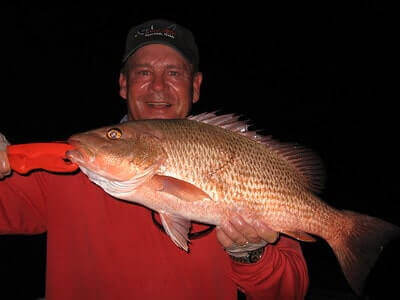
Table of Contents
- 1 How To Catch Mangrove Snapper
- 2 Best Baits For Mangrove Snapper
- 3 Best Lures For Mangrove Snapper
- 4 Mangrove Snapper Fishing Tackle
- 5 Best Rig For Mangrove Snapper
- 6 How To Catch Mangrove Snapper Offshore
- 7 How To Catch Mangrove Snapper Inshore
- 8 Mangrove Snapper Fishing At Night
- 9 How To Catch Mangrove Snapper In The Gulf of Mexico
- 10 How To Catch Mangrove Snapper In Texas
- 11 How To Catch Mangrove Snapper In Tampa Bay
- 12 How To Catch Mangrove Snapper In Louisiana
- 13 How To Catch Mangrove Snapper From A Dock
- 14 How To Catch Mangrove Snapper In the Florida Keys
- 15 Mangrove Snapper Fishing Tips
- 16 The Bottom Line
How To Catch Mangrove Snapper
1. Baitcasting
Baitcasting is a versatile and effective fishing method for targeting mangrove snapper, especially in shallow to moderately deep waters near structure-rich environments. Anglers typically use baitcasting reels paired with medium to medium-heavy rods, providing the necessary power to handle the potentially large and strong mangrove snapper.
To set up a baitcasting rig, anglers attach a leader line to the mainline using a swivel to prevent line twists. They then tie on a circle hook or J-hook, sized appropriately for the bait being used and the targeted size of mangrove snapper.
Bait options include live or cut baitfish, shrimp, crabs, or squid, which can be presented near mangrove roots, pilings, ledges, or other structures where mangrove snappers congregate. Anglers must accurately cast their baited rigs to specific targets near structure, ensuring the bait lands in areas where mangrove snapper are likely to be hiding.
Once the bait is in position, anglers must remain vigilant, carefully watching their lines for any signs of bites. When a mangrove snapper takes the bait, anglers must respond quickly but smoothly, setting the hook with a firm, upward motion to ensure a solid hookset. It’s essential to use the appropriate tackle and line strength to handle the powerful runs and headshakes of mangrove snapper. Anglers should also adhere to size and bag limits as well as any seasonal closures or regulations set forth by local authorities or regulatory bodies.
2. Chumming
Chumming is a tactic used to attract mangrove snapper to a specific area by dispersing a mixture of baitfish, fish parts, or other organic materials into the water. Once the snapper is attracted to the chum slick, anglers present baits or lures to entice strikes.
Chumming can be particularly effective when fishing around reefs, wrecks, or other structures where mangrove snappers are known to congregate. Anglers should use caution when chumming to avoid overfeeding the fish or attracting unwanted bycatch.
Successful chumming for mangrove snapper requires anglers to use the right chumming materials, deploy them strategically, and remain patient while waiting for the fish to respond. For more information on chumming techniques and regulations, anglers can consult resources provided by the National Oceanic and Atmospheric Administration (NOAA) Fisheries.
3. Bottom Fishing
Bottom fishing is one of the most popular methods for catching mangrove snapper. Anglers use various bottom rigs baited with live or cut baitfish, shrimp, crabs, or other natural baits to target mangrove snapper.
The rig is typically weighted to keep the bait near the seafloor where mangrove snapper tend to congregate. Once the bait is deployed, anglers wait patiently for the snapper to locate and strike. This method is highly effective when fishing around structures such as reefs, wrecks, rock piles, and bridges, where mangrove snapper are known to seek shelter and forage for food.
Successful bottom fishing for mangrove snapper requires anglers to use the right tackle, select appropriate bait, and deploy their rigs strategically to maximize their chances of success. For more information on bottom fishing techniques and regulations, anglers can consult resources provided by the National Oceanic and Atmospheric Administration (NOAA) Fisheries.
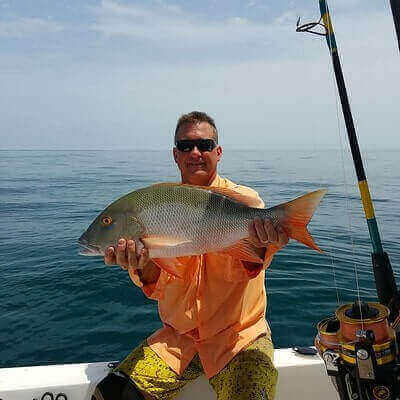
4. Still Fishing
Still fishing for mangrove snapper is a popular and effective method that involves presenting bait near structure-rich environments where these fish are abundant. Anglers typically use a variety of rigs such as the fish finder rig, knocker rig, or Carolina rig, depending on the depth and structure of the fishing area.
To set up a still fishing rig, anglers attach a circle hook or J-hook to a leader line and add an appropriate weight to keep the bait near the bottom. Bait options include live or cut baitfish, shrimp, crabs, or squid, which are enticing to mangrove snapper. Anglers then cast their baited rigs near mangrove roots, pilings, ledges, or other structure where mangrove snapper are likely to be hiding.
Once the bait is in position, anglers allow it to sit on the bottom, periodically checking for bites by feeling for subtle taps or observing line movement. When a mangrove snapper takes the bait, anglers should give the fish time to fully swallow the hook before setting it with a smooth, upward motion. It’s crucial to use the appropriate tackle and line strength to handle the powerful runs and headshakes of mangrove snapper.
Additionally, anglers should adhere to size and bag limits as well as any seasonal closures or regulations set forth by local authorities or regulatory bodies. For more information on still fishing techniques and regulations for mangrove snapper, anglers can consult resources provided by the National Oceanic and Atmospheric Administration (NOAA) Fisheries.
5. Fly Fishing
Fly fishing for mangrove snapper can be a rewarding and challenging endeavor that requires precision casting and strategic presentation. Anglers typically target mangrove snapper in shallow coastal waters near mangrove forests, docks, bridges, and other structure-rich environments where these fish are known to congregate.
To effectively catch mangrove snapper on the fly, anglers use lightweight fly rods, typically in the 6 to 8-weight range, paired with floating or intermediate sinking fly lines. Flies that mimic small baitfish, shrimp, or crustaceans are popular choices for enticing mangrove snapper to strike. Anglers may use both weighted and unweighted fly patterns depending on the depth and structure of the fishing area.
When fly fishing for mangrove snapper, accuracy in casting is paramount, as anglers must present their flies close to the structure without spooking the fish. Successful fly anglers employ stealthy approaches and precise casts to place their flies in the target zone and entice strikes from wary mangrove snappers.
It’s essential to retrieve the fly with short, sharp strips to mimic the erratic movements of prey and trigger a predatory response. Anglers may also experiment with different retrieve speeds and stripping patterns to determine what the fish find most enticing.
6. Drift Fishing
Drift fishing is another effective technique for targeting mangrove snapper, particularly when fishing over expansive areas of structure or natural habitat. Anglers drift with the current while presenting baits or lures at various depths to entice strikes from mangrove snappers.
This method allows anglers to cover a wide area efficiently and locate actively feeding fish. Drift fishing can be done using live baitfish, shrimp, or artificial lures such as jigs or soft plastics. Anglers adjust their drift speed and direction based on wind and current conditions to ensure optimal presentation of their baits or lures.
Successful drift fishing for mangrove snapper requires anglers to remain observant and responsive to changes in fish behavior and environmental factors.
7. Vertical Jigging
Vertical jigging is a highly effective technique for targeting mangrove snapper, especially when fishing in deeper water or around offshore structures. Anglers use heavy jigs or metal lures that imitate the movement of wounded baitfish or other prey species to attract strikes from mangrove snapper.
By dropping their jigs directly beneath the boat and jigging them up and down through the water column, anglers can entice aggressive strikes from snapper lurking near the bottom or suspended in the water column. Vertical jigging requires anglers to use specialized tackle, including stout rods and reels capable of handling heavy jigs and strong fish.
Successful vertical jigging for mangrove snapper relies on precise jigging motions, proper lure selection, and keen observation of fish behavior.
8. Live Bait Fishing
Live bait fishing is a traditional and effective method for targeting mangrove snapper. Anglers use live baitfish, shrimp, crabs, or other natural bait to entice strikes from these predatory fish. The key to success when live bait fishing for mangrove snapper is presenting the bait naturally and enticingly.
Anglers can fish live baits on the bottom, under floats, or suspended at various depths depending on the location and behavior of the fish. Live bait fishing requires anglers to use appropriate tackle, including hooks, leaders, and rigs designed to handle live bait and withstand the strong strikes of mangrove snapper. Anglers should also be prepared to monitor their baits closely and respond quickly to any signs of activity or bites.
9. Trolling
Trolling is a versatile and effective fishing method for targeting mangrove snapper, particularly when fishing in open water or along the edges of structure-rich environments such as reefs, channels, or drop-offs. Anglers employ this technique by trailing baited lines or lures behind a moving boat at varying speeds, depths, and distances from the vessel.
This method allows anglers to cover a wide area and explore different parts of the water column where mangrove snapper may be actively feeding or holding. To optimize trolling success, anglers often use downriggers, planers, or diving devices to control the depth at which their baits or lures are presented.
Additionally, anglers may vary their trolling speed and direction to adjust to changing conditions and fish preferences. Common trolling baits for mangrove snapper include live baitfish, artificial lures, and rigged baits such as strip baits or squid.
Successful trolling for mangrove snappers requires anglers to monitor their lines closely for strikes, adjust their trolling spread as needed, and maintain a consistent trolling pattern. For more information on trolling techniques and regulations, anglers can consult resources provided by the National Oceanic and Atmospheric Administration (NOAA) Fisheries.
Best Baits For Mangrove Snapper
- Shrimp
Shrimp is a highly effective bait for targeting mangrove snapper, offering anglers versatility and convenience in their pursuit. Anglers can either use live or fresh dead shrimp, depending on availability and personal preference.
To rig shrimp for mangrove snapper fishing, anglers typically thread the hook through the shrimp’s body, either from the tail to the head or vice versa, ensuring the hook is securely embedded to prevent it from easily tearing off during a strike.
Alternatively, anglers can use a small piece of shrimp as a trailer on a jighead or Carolina rig setup. When targeting mangrove snapper with shrimp, anglers should present the bait near structures such as rocks, reefs, mangrove roots, pilings, or ledges, where mangrove snapper are known to frequent. The key is to place the bait precisely where the snapper is feeding, enticing them to strike.
Once the bait is in position, anglers must maintain a watchful eye on their lines, looking for any subtle bites or nibbles. When a mangrove snapper takes the bait, anglers should wait for a moment, allowing the fish to fully engulf the shrimp before setting the hook with a smooth but firm motion.
It’s crucial to use the appropriate tackle and line strength to handle the strength and fighting capabilities of mangrove snapper. Anglers should also adhere to size and bag limits as well as any seasonal closures or regulations set forth by local authorities or regulatory bodies.
2. Crabs
Crabs are an excellent bait choice for targeting mangrove snapper due to their natural appeal and availability in coastal waters where mangrove habitats thrive. Anglers can catch crabs using various methods such as crab traps, dip nets, or even by hand in shallow tidal pools.
Once obtained, crabs can be prepared and rigged in different ways to attract mangrove snapper. One common method is to use a whole crab or sections of crab as bait, ensuring that the hook is securely embedded to prevent the crab from easily tearing off during a strike. Alternatively, anglers can use crab pieces as a trailer on a jighead or Carolina rig setup.
When presenting crab bait for mangrove snapper, anglers should focus on areas with structure such as rock piles, reefs, mangrove roots, or bridge pilings, as these are prime habitats for snapper to forage. It’s essential to position the bait close to the structure where mangrove snapper are likely to be hiding or feeding. Anglers should remain attentive to their lines, watching for any subtle bites or nibbles that may indicate a fish has taken the bait.
Once a mangrove snapper strikes, anglers should wait for a moment before setting the hook with a smooth but firm motion to ensure a solid hookup. As with any fishing activity, anglers should follow local regulations and size limits when using crabs as bait for mangrove snapper.
3. Minnows
Minnows are a versatile and effective bait for targeting mangrove snapper in a variety of fishing environments. Anglers can catch minnows using several methods, including cast nets, minnow traps, or even by hand in shallow waters near shorelines or mangrove habitats.
Once collected, minnows can be rigged in different ways to attract mangrove snapper. One popular approach is to hook the minnow through the lips or back, allowing it to swim freely and appear natural to predatory fish. Alternatively, anglers can use a jighead or Carolina rig setup with a live minnow as bait, presenting it near structure where mangrove snappers are known to congregate.
Mangrove snapper are often found around reefs, rock piles, mangrove roots, and other underwater structures, so anglers should focus their efforts in these areas. It’s crucial to adjust the weight of the rig to match the current and water depth to ensure the bait reaches the desired fishing zone effectively. Anglers should remain vigilant for any signs of activity, such as subtle bites or line movements, indicating that a snapper has taken the bait.
When a bite is detected, anglers should wait for a moment before setting the hook with a steady motion to secure the catch. It’s essential to handle live minnows carefully and use them responsibly to maintain their health and vitality as bait. Anglers should also adhere to local fishing regulations and size limits when using minnows for mangrove snapper fishing.
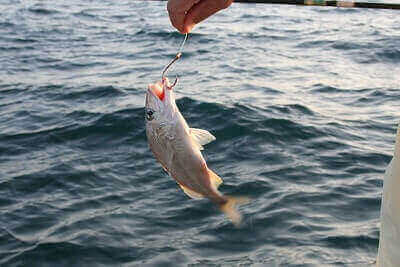
4. Pilchards
Pilchards, also known as scaled sardines, are a popular and effective bait choice for targeting mangrove snapper. These small, silvery fish are abundant in many coastal waters, making them relatively easy to catch for anglers. Pilchards can be caught using various methods, such as cast nets, sabiki rigs, or even by using a baitfish trap near shorelines, docks, or other structures where they congregate.
Once caught, pilchards can be rigged in several ways to entice mangrove snapper. One common method is to hook the pilchard through the nose or behind the dorsal fin, allowing it to swim naturally and attractively in the water. Anglers can also use a variety of rigs, including knocker rigs or Carolina rigs, to present the pilchard near the bottom where mangrove snapper often feeds.
When fishing with pilchards, it’s essential to match the hook size and rig setup to the size of the baitfish and the target species. Anglers should also pay attention to the current and water depth to ensure the bait is presented effectively in the strike zone. Additionally, anglers can enhance the attractiveness of pilchards by adding scent or using a chumming technique to attract mangrove snapper to the area.
It’s crucial to handle pilchards carefully to maintain their liveliness and maximize their effectiveness as bait. Anglers should also be aware of local regulations regarding the collection and use of baitfish to ensure sustainable fishing practices. For more information on baitfish regulations and conservation guidelines, anglers can consult resources provided by the National Oceanic and Atmospheric Administration (NOAA) Fisheries.
5. Pinfish
Pinfish are a common and effective bait choice for targeting mangrove snapper. These small fish are abundant in coastal waters throughout the Gulf of Mexico and along the southeastern coast of the United States. Anglers can catch pinfish using a variety of methods, including bait traps, cast nets, or small hooks with bits of shrimp or squid as bait.
Once caught, pinfish can be rigged in different ways to attract mangrove snapper. One popular method is to hook the pinfish through the back or just behind the dorsal fin, allowing it to swim freely and appear natural in the water. Alternatively, anglers can use a variety of rigs, such as knocker rigs or Carolina rigs, to present the pinfish near the bottom where mangrove snapper are often found.
When using pinfish as bait, it’s essential to match the hook size and rig setup to the size of the baitfish and the target species. Anglers should also pay attention to factors such as current and water depth to ensure the bait is presented effectively in the strike zone.
Additionally, anglers can enhance the attractiveness of pinfish by adding scent or using chum to attract mangrove snapper to the area. It’s important to handle pinfish carefully to keep them lively and maximize their effectiveness as bait. Anglers should also be aware of local regulations regarding the collection and use of baitfish to ensure sustainable fishing practices.
6. Squid
Squid is a highly effective bait for targeting mangrove snapper, prized for its durability and strong scent attraction. Anglers can catch squid using a variety of methods, including jigging, casting with squid jigs, or deploying baited traps in areas where squid are known to inhabit, such as near artificial reefs or underwater structures.
Once caught or purchased from bait shops, squid can be prepared and rigged in different ways to entice mangrove snapper. One common rigging method involves threading a whole or cut squid onto a hook, either through the mantle or by using strips of squid as bait.
Anglers may also opt to use squid tentacles or heads as bait, depending on the size and preference of the target fish. When presenting squid as bait for mangrove snapper, it’s essential to use appropriate tackle and rigging to ensure the bait is presented naturally and securely in the water column or near the bottom where mangrove snapper typically feed.
Anglers can experiment with different rig setups, including Carolina rigs, knocker rigs, or dropper rigs, to find the most effective presentation for the given fishing conditions. Additionally, adding scent or attractants to the squid bait can further enhance its effectiveness in enticing mangrove snapper strikes.
It’s important for anglers to adhere to local regulations regarding the use of squid as bait and to practice sustainable fishing methods to help conserve marine resources. For more information on fishing regulations and conservation guidelines, anglers can consult resources provided by the National Oceanic and Atmospheric Administration (NOAA) Fisheries.
7. Mullet
Mullet is a popular and effective bait for targeting mangrove snapper, known for its strong scent and natural appearance in the water. Anglers can catch mullet using various methods, including cast netting, angling with hook and line, or trapping.
Cast netting is a common method used to catch mullet in shallow coastal waters, where schools of mullet are often found swimming near shorelines, flats, or estuaries. Anglers proficient in throwing cast nets can target these areas during incoming tides or periods of high activity to capture live mullet for bait.
Alternatively, mullet can also be caught using hook and line methods, such as using small hooks baited with bits of shrimp or worm to entice mullet bites. Another method involves setting baited traps or fyke nets in strategic locations where mullet are known to congregate, allowing anglers to collect mullet in larger quantities for bait.
Once obtained, mullet can be rigged as bait for mangrove snapper using various techniques, including whole fish, fillets, or chunks depending on the size and preference of the target fish. Anglers can rig mullet on circle hooks, J-hooks, or even specialized bait rigs designed for bottom fishing applications.
It’s essential to present mullet bait naturally and securely to maximize its effectiveness in enticing mangrove snapper strikes. Anglers should also be mindful of local regulations regarding the harvest and use of mullet as bait and practice responsible fishing practices to support sustainable fisheries management. For more information on fishing regulations and conservation guidelines, anglers can consult resources provided by the National Oceanic and Atmospheric Administration (NOAA) Fisheries.
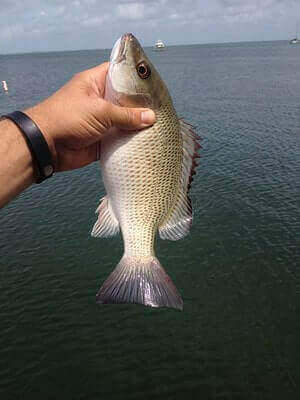
Best Lures For Mangrove Snapper
- Spoons
Spoons are versatile and effective lures for targeting mangrove snapper in a variety of fishing environments. These metal lures mimic the movement of baitfish, making them enticing to predatory fish like mangrove snapper. Anglers can use spoons in different ways, including casting and retrieving, jigging, or trolling, depending on the fishing conditions and desired presentation.
When casting and retrieving spoons, anglers can imitate injured baitfish by varying the speed and action of the retrieve to entice strikes from feeding mangrove snapper. Jigging with spoons involves dropping the lure vertically and imparting erratic movements to mimic wounded prey, making it an effective method for targeting snapper holding near structure or on the bottom.
2. Topwater Plugs
Topwater plugs are an exciting and effective lure choice for targeting mangrove snapper, particularly in shallow waters or around structure-rich environments like mangrove shorelines, docks, and bridge pilings. These lures are designed to create surface disturbance and mimic the movement of injured baitfish, enticing predatory fish like mangrove snapper to strike.
When fishing with topwater plugs, anglers can employ a variety of techniques to maximize their effectiveness. One popular method is the “walk-the-dog” retrieve, where the angler imparts a side-to-side zigzagging action to the lure by twitching the rod tip during the retrieve. This action closely resembles the movement of a wounded baitfish struggling at the surface, making it irresistible to hungry snapper.
3. Soft Plastics
Soft plastics are versatile and effective lures for targeting mangrove snapper in various fishing conditions. These artificial baits come in a wide range of shapes, sizes, and colors, mimicking the appearance and movement of natural prey such as shrimp, baitfish, and crabs. When fishing for mangrove snapper with soft plastics, anglers have the flexibility to adapt their presentation to match the prevailing conditions and the preferences of the fish.
Rigging options for soft plastics include Texas rigs, Carolina rigs, jig heads, and weedless hooks, allowing anglers to fish them effectively in different habitats, from shallow flats to deep reefs. One popular technique when using soft plastics for mangrove snapper is a slow, subtle retrieve, mimicking the natural movement of prey. Anglers can also experiment with erratic twitches and pauses to trigger strikes from curious or aggressive fish.
Soft plastics can be especially productive when targeting mangrove snapper holding in areas with heavy structure or cover, as their weedless designs help reduce snagging and increase hookup rates. Additionally, scented soft plastics infused with fish-attracting scents can further entice wary snapper and mask any unnatural odors that might deter strikes. Overall, soft plastics are a versatile and reliable option for anglers seeking to catch mangrove snapper in a variety of fishing scenarios, providing an effective alternative to live bait while still producing excellent results.
4. Jigs
Jigs are highly effective lures for targeting mangrove snapper in a variety of fishing environments, from shallow flats to deeper offshore structures. These versatile baits consist of a weighted head with a hook, often adorned with a soft plastic or feather tail. The design allows for precise control over the presentation, making jigs ideal for enticing strikes from wary snappers.
Anglers can choose from a wide range of jig styles, including bucktail jigs, paddle tail jigs, and vertical jigs, each offering unique advantages depending on the fishing conditions. When fishing for mangrove snapper with jigs, anglers can employ a variety of retrieval techniques, including jigging vertically near structure or casting and retrieving along the bottom.
The key is to mimic the movement of natural prey, such as shrimp or small baitfish, by imparting lifelike action to the jig. Additionally, anglers can experiment with different colors and sizes to match the local forage and entice strikes from feeding snappers.
Jigs are particularly effective when targeting mangrove snapper holding near reefs, wrecks, rock piles, and other submerged structures, where these predatory fish often congregate in search of food and shelter. Overall, jigs are a versatile and reliable lure option for anglers targeting mangrove snapper, offering excellent hookup rates and the potential for trophy-sized catches.
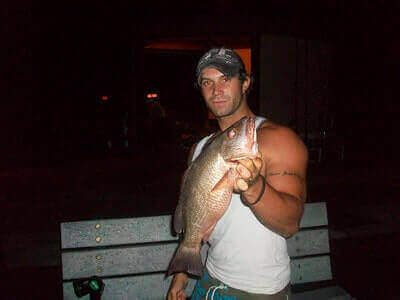
Mangrove Snapper Fishing Tackle
A 6 to 7-foot medium to medium-heavy fast action rod spooled with a 10-pound braided line and a 15-pound leader will work when fishing for mangrove snapper. Circle hooks sizes 1/0 to 4/0, are the best choice of hooks when fishing for mangrove snappers. They have very good eyesight and fluorocarbon leaders are the best option when fishing for mangrove snapper.
Best Rig For Mangrove Snapper
The best rig for mangrove snapper will depend on where you will be fishing. If you are fishing in shallow water inshore, then a live bait rig or a split shot rig will work. This rig consists of a live shrimp on a 1/0 circle hook with a split shot rig or under a popping cork depending on where the mangrove snapper is located. A sliding sinker rig or a fish finder rig will also work for inshore fishing
However, if you are fishing for mangrove snapper offshore, then the offshore mangrove snapper rig will get the job done. A two-hook rig will also work when fishing for mangrove snapper in deep water. Additionally, a weighted fishing rig, such as a knocker rig, will work well for bottom fishing. These are mangrove snapper rigs often used by anglers.
How To Catch Mangrove Snapper Offshore
When fishing for mangrove snapper offshore, you will use heavy tackle since you will be targeting large mangrove snappers in deeper waters. Conventional rods, large hooks, and weights are the tackle that is used when fishing for mangrove snapper offshore.
The presentation is very crucial when fishing for mangrove snapper offshore and the offshore mangrove snapper rig is one rig that works well when fishing offshore for mangrove snapper in deep waters.
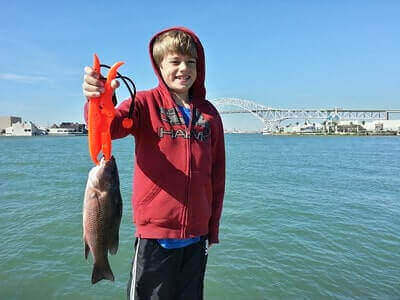
How To Catch Mangrove Snapper Inshore
Mangrove snapper can be caught when fishing inshore. They are often found in shallow waters, near rock piles, mangroves, bridges, docks, and piers. When fishing for mangrove snapper inshore, use light tackle to target mangrove snappers. Spinning rods, small hooks, and weights are used.
The right presentation is also important and a split shot rig or a live bait rig will work well. This rig for mangrove snapper is a live shrimp on a 1/0 circle hook with a split shot rig or under a popping cork depending on where the mangrove snapper is located. Baitcasting is one of the fishing methods that can be used when fishing for mangrove snapper inshore.
Mangrove Snapper Fishing At Night
Fishing for mangrove snapper at night can be very productive. During the summer, night fishing for mangrove snapper is the best time to catch them. When it is a full moon, you will have a better time fishing for mangrove snappers. Additionally, the nights just before and after the full moon will be the best times to go fishing for mangrove snapper.
Moreover, when fishing for mangrove snapper at night, chumming is very important. This will attract the fish closer to you. Just be aware that your chum may attract other large fish like sharks which will shut the bite down. Frozen bait works well for night fishing and shrimp, squid, sardines, and silversides are some of the baits used for fishing mangrove snappers at night. Baitcasting is also used when fishing for mangrove snappers.
How To Catch Mangrove Snapper In The Gulf of Mexico
The Gulf of Mexico is a prime fishing destination for many anglers as there are many different species of fish there. From gamefish to regular-sized fish, anglers have a variety of fish that they can target in the Gulf of Mexico.
Summer is a great time to target mangrove snapper in the Gulf of Mexico as it is calm and you can easily get to the wrecks and reefs. When fishing for mangrove snapper in the Gulf of Mexico, you can target them inshore and offshore. When targeting them inshore, look for structures like wrecks, reefs, seawalls, ledges, downed trees, or logs.
When fishing inshore, you can cast baits, chum, and bottom fish for mangrove snapper. Baits such as squid, pinfish, pilchards, minnows, and mullets can be used. Live bait, cut bait or dead bait can be used when fishing for mangrove snapper.
When fishing offshore, the popular fishing method anglers use is bottom fishing. You can use bottom fishing in the Gulf of Mexico to target mangrove snappers that are further down in the water column. Anglers use different bait and lure at the bottom to attract mangrove snappers to bite.
Additionally, anglers are more successful fishing for mangrove snappers when the waters are muddy or discolored. When there are windy days which will stir up the water and make it murky, the mangrove snapper will not clearly see the leader and this presents a good opportunity for anglers to catch them. Anglers will anchor the up-current of the structure and get a chum line going.
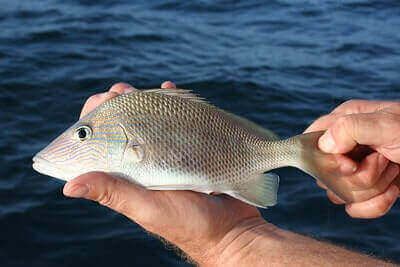
How To Catch Mangrove Snapper In Texas
Texas, also in the Gulf of Mexico, is a good fishing location for Anglers. It holds a large species of fish including mangrove snapper. Like most areas of the Gulf of Mexico, you can fish inshore and offshore for mangrove snappers.
Baitcasting, chumming, bottom fishing, night fishing fly fishing, and still fishing are some of the fishing methods used when fishing for mangrove snapper inshore and offshore in Texas. There are no bag or size limits for mangrove snapper in the state of Texas
How To Catch Mangrove Snapper In Tampa Bay
Tampa Bay, like many other areas in the Gulf of Mexico, is blessed with a variety of species of fish. Mangrove snapper is one of those found in the waters of Tampa Bay that are targeted by anglers. It can be found inshore and offshore which makes mangrove snapper a good gamefish for anglers.
Bottom fishing, baitcasting, chumming, still fishing, night fishing, and fly fishing are fishing methods that anglers use when fishing for mangrove snapper in Tampa Bay. Live and frozen bait work well when fishing for mangrove snapper in Tampa Bay, although live bait is the best bait to use.
Pinfish, squid, mullet, minnows, and pilchards are some of the baits that can be used either live or cut for mangrove snapper fishing. The size limit for mangrove snapper in Tampa Bay is 10 inches.
How To Catch Mangrove Snapper In Louisiana
Louisiana features natural structures and oil rigs that are used by mangrove snappers as cover. It also has a wide variety of species of fish including mangrove snapper that anglers target from late spring to early fall.
Bottom fishing, baitcasting, night fishing, fly fishing, chumming, and still fishing are some of the fishing methods and techniques used when fishing for mangrove snapper. Pilchards, minnows, squid, mullet, and pinfish are some of the baits that are used when fishing for mangrove snapper in Louisiana. The mangrove snapper Louisiana size limit is 12 inches.
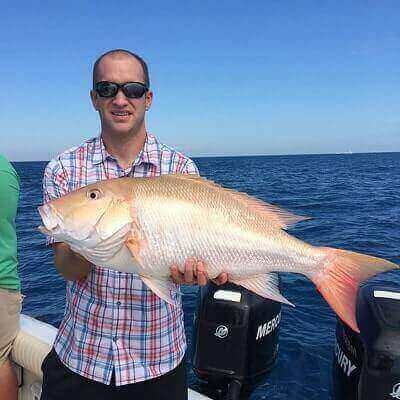
How To Catch Mangrove Snapper From A Dock
Mangrove snapper can be found around structures like bridge pilings, piers, oil rigs, and docks. When fishing for mangrove snapper from a dock, one of the fishing techniques used by anglers is chumming. Pieces, strips, or chunks of bait will be dropped into the water to attract the fish.
When they pick up the scent of the bait and come to feed on it, this will bring them closer to you and then you can drop your bait with the hook to hook and reel them in. Squid, minnows, pilchard, shrimp, pinfish, and mullet are some of the bait that can be used when chumming.
Baitcasting is also another fishing method that can be used when fishing for mangrove snapper from the dock. It is often done after chumming. Still fishing can also be used to catch mangrove snapper from the dock.
How To Catch Mangrove Snapper In the Florida Keys
The Florida Keys is another regular fishing destination for many anglers. There are many species of fish in the Florida Keys for anglers to target including mangrove snappers. June is one of the best months to target mangrove snappers in the Florida Keys. At this time of the year, the Gulf of Mexico is calm and anglers can easily get to wrecks, reefs, and other structures that serve as cover for mangrove snappers.
You can target mangrove snapper inshore and offshore in the Florida Keys. Chumming, baitcasting, bottom fishing, night fishing, fly fishing, and still fishing are some of the fishing methods that are used when targeting mangrove snappers.
Baits and lures can be used when fishing for mangrove snappers. Both live and dead baits work well and squid, pinfish, minnows, pilchards, mullets, blue crabs, and shrimp can be used live or cut when fishing for mangrove snapper. The mangrove snapper Florida size limit is 10 inches.
Mangrove Snapper Fishing Tips
- The best time of the day to catch mangrove snapper is early morning and late evening.
2. The best time of the year to catch mangrove snapper is from May to September when Mangrove Snapper is very active as the water temperature rises. The peak period for catching mangrove snappers is June to August.
3. Mangrove snapper is notorious for stealing bait. Use 1/0 circle hooks when fishing for mangrove snappers.
4. Mangrove snappers also have very good eyesight. Therefore, use a light 8 to 10-pound fluorocarbon leader.
5. Despite its size, the mangrove snapper is a good fighter.

6. A simple yet effective rig for fishing mangrove snapper is a live shrimp on a 1/0 circle hook with a split shot or under a popping cork depending on where the mangrove snapper is in the water column.
7. Mangrove snappers spawn from June to September close to offshore and near-shore reefs.
8. During the spawn, you can catch large mangrove snappers inshore.
9. They are active during the Summer and can be found in grass flats, mangroves, and near structures like bridge pilings, piers, and docks.
10. Mangrove snapper likes to eat glass minnows and pilchards on grass flats.
11. Use live pilchards under a popping cork to catch mangrove snappers in grass flats.

12. Mangrove snappers can also be found around sandy potholes in grass flats. Get your live bait around the sandy potholes for mangrove snappers to go after it.
13. Most lures work well when mangrove snapper is feeding on fish on the grass flats.
14. The phases of the moon also affect the feeding patterns of mangrove snappers. They are more active during full and new moon phases.
15. Incoming tides are the best tide conditions when fishing for mangrove snapper as the tide brings baitfish into shallow water.
16. Calm seas and overcast skies are the best weather conditions when fishing for mangrove snapper as it is easier to see them when fishing.
17. When fishing for mangrove snapper, hook sizes ranging from 1/0 to 4/0 will work depending on the size of the fish and the bait.

The Bottom Line
Mangrove Snapper (Lutjanus griseus) is a highly sought-after fish for anglers. It is a hard fighter, can be found inshore and offshore, and is delicious with its delicate flavor and firm flesh. Mangrove snappers are found in the Gulf of Mexico, the Atlantic Ocean, and the Caribbean. They like structures where they can take shelter to ambush their prey.
In this article, we discussed how to catch mangrove snapper, the best fishing methods anglers use when fishing for mangrove snapper, as well as the baits, lures, and fishing tackle. You can also read how to catch yellowtail snapper, how to catch red snapper, how to catch lane snapper, how to catch rock hind, how to catch mutton snapper, how to catch vermillion snapper, how to catch cubera snapper, and how to catch triggerfish.